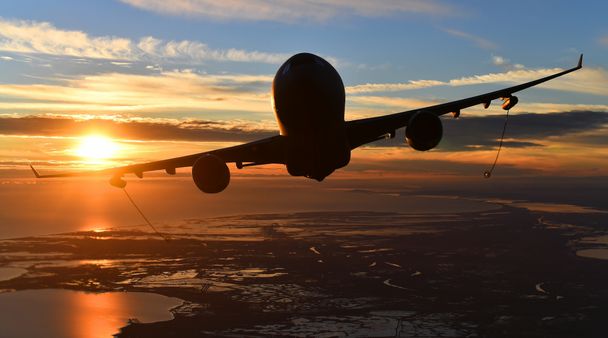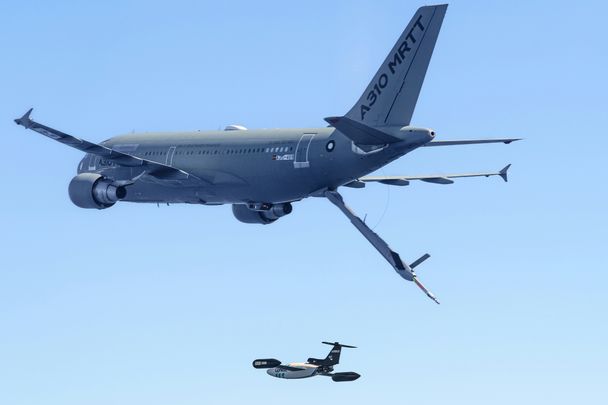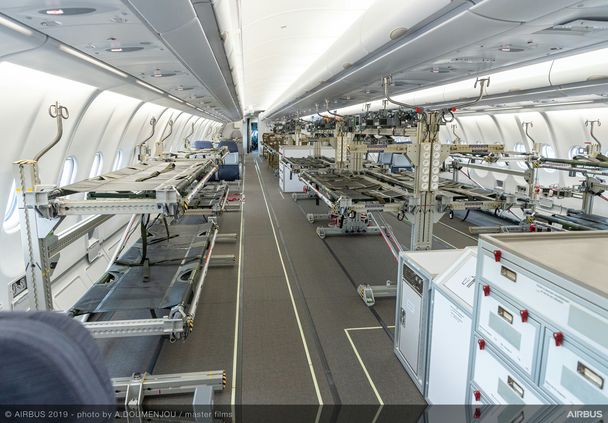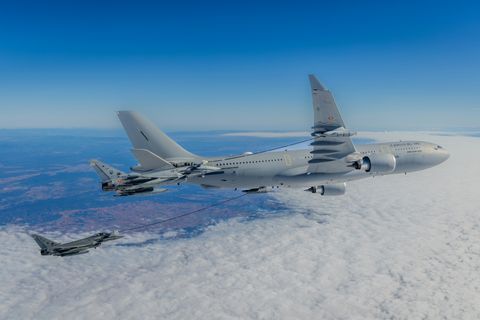A330 MRTT: the evolution of the world's leading air-to-air refuelling tanker

With more than 300,000 flight hours and 15 customers worldwide, the A330 Multi Role Transport Aircraft (MRTT) is more than just a tanker. From pioneering automatic refuelling to taking connectivity to the next level, here are ten facts about the aircraft that help keep it ahead of the game.
1. Ready for mission
With ten operators and 15 user nations, the A330 Multi Role Transport Aircraft (MRTT) fleet has accumulated more than 300,000 flight hours. This operational readiness is reflected in the fact that the Airbus tanker is approved to refuel more than 25 different aircraft receivers, either using the hose and drogue or boom refuelling systems, or the fuselage refuelling unit for large probe-equipped aircraft such as the A400M. With a market share of over 90% (outside the US), the A330 MRTT has been ordered by launch customer Australia , France, NATO’s Multinational MRTT Fleet (MMF), Saudi Arabia, Singapore, South Korea, the United Arab Emirates, the United Kingdom, Spain and Canada. A total of 82 aircraft have been sold to date.
A330 MRTT: 300,000 flight hours and counting
2. Automatic refuelling, day and night!
The A330 MRTT features pioneering advances such as fly-by-wire control for the refuelling boom, and a high-resolution 2D/3D digital system that improves visibility for refuelling operators. Together with the Republic of Singapore Air Force (RSAF), Airbus launched the SMART MRTT project a few years ago. This saw the world's first automatic air-to-air refuelling (A3R) using the boom system, with certification for daytime operations achieved in 2022.
In July this year, Airbus continued the development by conducting more than 500 night automatic refuelling tests, which should enable certification for night operations by early next year. The RSAF is already using the A3R's groundbreaking daytime refuelling capability. Other operators are expected to follow.
VIDEO A330 MRTT Automatic Air-to-Air Refuelling (Night Ops)
3. The transition to the A330 MRTT+
Airbus is preparing a new major evolution of the tanker, through the A330 MRTT+ programme. The A330-200 baseline aircraft will be replaced by the A330neo (A330-800). The main changes are to the wings and engines, while the passenger cabin will also be improved. These aerodynamic and propulsion improvements are expected to reduce the aircraft's fuel burn by up to 8%, allowing for more range and/or offload capacity. Furthermore, Airbus is working at expanding the connectivity of the A330 MRTT, turning the tanker into a battlefield communications node. Following a development phase, the A330 MRTT+ is expected to be introduced to customers in the coming years.

4. Towards fully autonomous operations
Airbus is exploring further automation that would allow the tanker to control the aircraft being refuelled, with or without a crew. The 18-month Auto'Mate campaign tested a technology demonstrator designed to explore and develop Autonomous Assets Air-to-Air Refuelling (A4R) and Autonomous Formation Flight (AF2) operations. The idea is to automate the entire refuelling process. This entails tankers autonomously guiding a 'receiver' aircraft into position, followed by fuel transfer and safe separation. Auto'Mate paves the way for in-flight refuelling of non-piloted combat aircraft such as drones, as well as reusing technologies in remote carrier and ‘wingman' operations - key unmanned elements of Europe's Future Combat Air System (FCAS).

Airbus used its A310 MRTT for the Auto'Mate flight campaign. Over the years, the company has used this flying testbed for air-to-air refuelling developments and in-house innovative projects, such as the A330 MRTT boom refuelling system. The boom introduced new technologies such as electric actuators, a hoist, flight controls, a high-resolution digital vision system and new capabilities such as a fuel flow rate of 1200 US gallons per minute, dual redundancy and envelope protection.
5. Enabling air power projection
This summer, the A330 MRTT joined forces with other Airbus military aircraft to play a crucial role in the Pacific Skies 24 major overseas joint airlift. France, Singapore, the UK and the German-led Multinational MRTT Unit (MMU) all relied on the aircraft for logistical support, in addition to its primary tanker role.
Indeed, the MRTT's air-to-air refuelling capability has been a driving force behind the air forces' air power projection in recent years. The French Air and Space Force's annual long-range Pégase mission in the Indo-Pacific region in 2021 saw frontline fighters fly 17,000 km to Polynesia in 48 hours, while the Royal Air Force's Mobility Guardian exercise in 2023 saw an A400M make the longest flight ever undertaken by a propeller aircraft: a non-stop journey of over 11,000 km to the Pacific island of Guam. Both record flights were supported by in-flight refuelling from the A330 MRTT.

6. Protecting national and European sovereignty
The A330 MRTT is a key asset in strengthening Europe's strategic autonomy and security. Since Russia's invasion of Ukraine, the tanker has supported NATO's Air Shielding mission, which uses fighter jets and ground-based air defence systems to protect the skies and borders of eight member countries. The area represents over 2,500 kilometres of territory stretching from Estonia to Bulgaria. Playing its part, NATO's MMU fleet, currently comprising eight of the ten aircraft ordered, provides air-to-air refuelling for allied fighters, increasing their interoperability, flight time and readiness.
Video A330 MRTT
7. Pooling and sharing, adding value for the customer
The Multinational MRTT Fleet (MMF) is a unique example of cooperation between NATO and the European Union in the provision of critical capabilities. The fleet includes aircraft belonging to Germany, the Netherlands, Belgium, Norway, Luxembourg and the Czech Republic under a pooling and sharing approach. Participating nations share costs in proportion to their annual flight hours, benefiting from economies of scale. In the UK, the Air Tanker Consortium manages the maintenance, infrastructure, crew training and spares required to support the Royal Air Force's 14 MRTT aircraft. Created through a Private Finance Initiative pooling government and private sector investment, this arrangement allows the Consortium to use any spare aircraft for short-term air charter or lease to other commercial airlines for commercial gain.

8. Medical evacuation and humanitarian relief
The A330 MRTT does not require auxiliary fuel tanks. The main cabin and lower deck cargo areas can easily meet troop or equipment transport requirements, while providing in-flight refuelling, all in a single mission. The aircraft can be configured for medical evacuation of up to 40 light care patients. Operators such as the French Air and Space Force have developed a dedicated ‘Morphée’ intensive care module to enable the transport of six to 12 critically injured patients over a distance of 10,000 km.
The A330 MRTT is also a valuable tool in humanitarian relief operations. French A330 MRTTs, named ‘Phénix’, supported the deployment of firefighters and rescue teams following the devastating earthquake that struck Turkey and Syria in February 2023. Two months later France, Spain and the UK used the A330 MRTT to evacuate their nationals and other foreign citizens from Sudan in a complex and highly critical situation, as a spiral of violence rapidly spread across the country.

A French Air and Space Force A330 MRTT cabin configured for medical evacuation.
9. Pioneering the use of sustainable aviation fuel
With the potential to reduce lifecycle carbon emissions by up to 80% compared to conventional fuel, sustainable aviation fuel (SAF) will play an increasing role in the decarbonisation of the defence sector. In November 2022, the Royal Air Force became the world’s first operational military aircraft to fly on pure sustainable aviation fuel. Since then, the RAF has conducted further SAF trials, including the first use onboard the Eurofighter of SAF blended with regular aviation fuel. The fighters received the blend as part of an in-flight refuelling exercise from a Voyager MRTT aircraft in April 2023.

The Royal Air Force, Airbus and other industry partners carried out the world’s first 100% Sustainable Aviation Fuel using an in-service military aircraft in 2022.
10. Made in Europe for the world
It all started 20 years ago when a group of bold people developed the first in-flight boom refuelling system in Airbus history, in a market that was then served by a single supplier. Few could have imagined that the A330 MRTT would go on to become the world's leading refuelling aircraft. The A330-200 is assembled at Airbus’ Toulouse, France final assembly line, before transferring to the MRTT conversion centre at Airbus' Getafe facility in Spain. The conversion takes approximately one year, from disassembly, mechanical and electrical modifications (wiring, avionics) to functional testing and refurbishment (re-installation of components). This optimised industrial process enables the conversion of about five aircraft per year.




